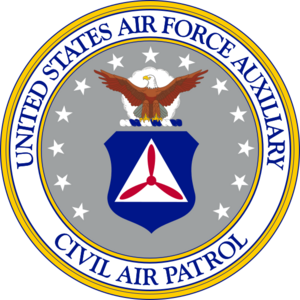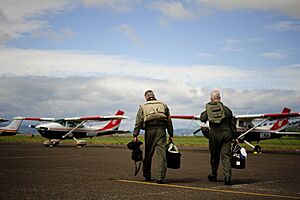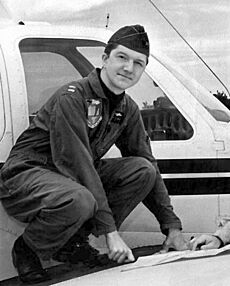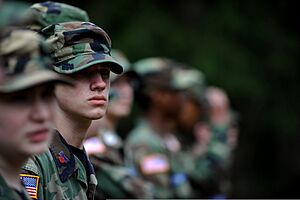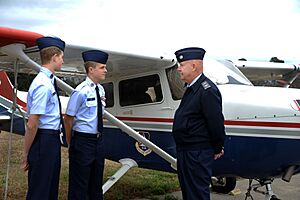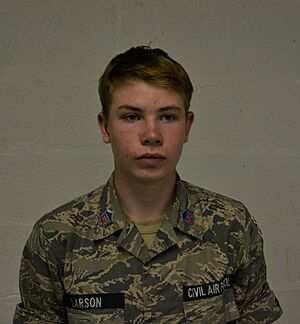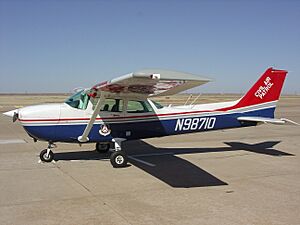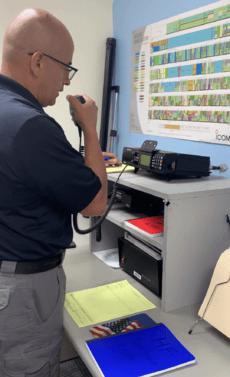Civil Air Patrol facts for kids
Quick facts for kids Civil Air Patrol |
|
|---|---|
| Founded | 1 December 1941 |
| Country | |
| Branch | |
| Type | Civilian auxiliary |
| Role |
|
| Size |
|
| Part of | |
| Headquarters | Maxwell Air Force Base Montgomery, Alabama, U.S. |
| Motto(s) | Semper Vigilans Always Vigilant |
| March | "The C.A.P. Is on the Go" |
| Anniversaries | 1 December |
| Engagements | Antisubmarine, World War II |
| Commanders | |
| National Commander | |
| National Vice Commander | |
| National Command Chief | |
| Insignia | |
| Flag |  |
| Roundel |  |
| Command Emblem |  |
| Aircraft flown | |
|
|
The Civil Air Patrol (CAP) is a special non-profit group in the United States. It's like a helpful partner to the United States Air Force (USAF). CAP is made up of volunteers who love aviation and come from all walks of life.
This organization has two main types of members. Cadets are young people aged 12 to almost 21. Senior members are adults aged 18 and older. Both groups get to do many exciting things. The cadet program helps young people grow with a clear plan and a structure similar to the Air Force. Older members act as teachers, leaders, and helpers. Most members wear uniforms when they are working.
CAP is a big user of small, single-engine airplanes. They use these planes for different tasks. This includes giving orientation flights to cadets. They also provide important emergency services. Because there are so many chances to fly, many CAP members become licensed pilots.
The Civil Air Patrol is organized like a military group. It has a clear chain of command. The main office is called the National Headquarters. Below that are eight regional commands. Then there are 52 "wings," one for each state, plus Washington, D.C., and Puerto Rico. Each wing oversees smaller groups and squadrons, which are the basic units.
Contents
What is the History of Civil Air Patrol?
The idea for Civil Air Patrol started in the late 1930s. An aviation supporter named Gill Robb Wilson thought that regular civilian planes could help the military. With help from New York Mayor Fiorello H. LaGuardia, CAP was officially created on December 1, 1941.
During World War II, CAP helped the war effort. They flew patrols to look for enemy submarines. They also guarded borders and delivered messages. CAP's coastal patrols flew millions of miles. They spotted many enemy submarines. Sadly, 68 CAP members died during the war.
After World War II, CAP became the official helper, or auxiliary, of the U.S. Air Force on May 26, 1948. Its rules said it would never be involved in direct fighting again. Instead, it would focus on helpful, non-combat activities. Since then, CAP has continued its three main missions.
In 2011, Civil Air Patrol received the Roving Ambassador of Peace award. This was for its good work in communities. It also recognized its efforts to save lives. In 2014, members who served in World War II received the Congressional Gold Medal. This honored their military service.
In 2021, CAP won the Master's Trophy for North America. This was for their help during the COVID-19 pandemic. They also helped with disaster relief after Hurricane Ida.
How is Civil Air Patrol Organized?
Even though it's a civilian group, Civil Air Patrol is set up like the military. It has a clear chain of command. It also uses a rank system similar to the U.S. Air Force. There are several levels in its structure:
- National Headquarters
- Regions
- Wings
- Squadrons
- Flights
Sometimes, a group level is added between a wing and its squadrons. This happens if the wing commander thinks it's needed.
National Headquarters
The leaders of CAP are volunteers. The top leader is the National Commander. This person is a CAP major general. The National Headquarters is located at Maxwell Air Force Base in Montgomery, Alabama.
The headquarters has a professional staff of over 100 people. They manage programs and support the more than 1,700 volunteer units across the United States.
There is also a special U.S. Air Force unit called Headquarters Civil Air Patrol-U.S. Air Force (CAP-USAF). This unit helps make sure CAP is ready for Air Force missions. They also connect CAP with the U.S. Air Force and other government groups.
Regions and Wings
Below the National Headquarters are eight geographic regions. Each region is led by a CAP colonel. Each region includes several statewide groups called wings. There are 52 CAP wings. This includes one in each of the 50 states, one in Washington, D.C., and one in Puerto Rico.
Each wing has a commander, who is also a CAP colonel. This commander oversees a staff of experienced volunteers.
The regions and their wings are:
- Northeast Region: Connecticut, Maine, Massachusetts, New Hampshire, New Jersey, New York, Pennsylvania, Rhode Island, and Vermont wings.
- Mid Atlantic Region: Delaware, Maryland, National Capital (District of Columbia), North Carolina, South Carolina, Virginia, and West Virginia wings.
- Great Lakes Region: Illinois, Indiana, Kentucky, Michigan, Ohio, and Wisconsin wings.
- Southeast Region: Alabama, Florida, Georgia, Mississippi, Puerto Rico, and Tennessee wings.
- North Central Region: Iowa, Kansas, Minnesota, Missouri, Nebraska, North Dakota and South Dakota wings.
- Southwest Region: Arizona, Arkansas, Louisiana, New Mexico, Oklahoma, and Texas wings.
- Rocky Mountain Region: Colorado, Idaho, Montana, Utah, and Wyoming wings.
- Pacific Region: Alaska, California, Hawaii, Nevada, Oregon, and Washington wings.
Squadrons and Flights
Local units are called squadrons. Squadrons are the main working parts of CAP. They carry out plans from higher levels.
CAP squadrons can be cadet, senior, or composite.
- A composite squadron has both cadets and senior members.
- A senior squadron has only senior members. They focus on emergency services or aerospace education.
- A cadet squadron is mostly cadets. It has a few senior members to supervise.
The smallest CAP unit is a flight. Flights are usually temporary. They are formed in areas with too few members to make a squadron. The goal is to grow into a full squadron. A flight can have up to 14 members.
What are Civil Air Patrol's Missions?
Civil Air Patrol has three main missions:
- Emergency Services: Helping people in emergencies.
- Aerospace Education: Teaching about aviation and space.
- Cadet Programs: Developing young leaders.
Emergency Services
CAP helps in several emergency areas. These include search and rescue, disaster relief, and helping people in need. They also support the United States Air Force.
CAP is well known for its search and rescue (SAR) work. They are involved in about three-quarters of all aerial inland SAR missions. These missions are directed by the United States Air Force Rescue Coordination Center. CAP is credited with saving about 100 lives each year.
CAP also helps a lot with disaster relief. This is especially true in areas hit by hurricanes or tornadoes. CAP planes take pictures to help emergency managers see damage. They also transport supplies and people. After the September 11 attacks, a CAP plane was one of the first to fly over the World Trade Center site to take photos.
CAP also helps with humanitarian missions. They often work with the Red Cross. CAP planes transport important medical items like blood.
CAP supports the Air Force in non-combat ways. This includes checking damage and transporting materials. They also help train USAF pilots. CAP planes fly into special airspace. This allows Air Force pilots to practice intercepting "enemy" aircraft.
CAP also helps other government groups. This includes the U.S. Customs and Border Protection and the Drug Enforcement Administration. They help in the fight against illegal substances. CAP uses special imaging systems on their planes. These systems can find certain objects from the air.
Aerospace Education
The Aerospace Education Program teaches members about aviation. It includes courses on flight physics, history, and space. There are also programs for CAP pilots to improve their flying skills.
Cadets have a required aerospace education program. To move up in rank, they must take courses and tests about aviation. Cadets also learn through museum visits and special activities.
Senior members can also study aerospace. Those who finish the program can earn the Charles E. "Chuck" Yeager Aerospace Education Award.
CAP also helps school teachers. They provide seminars and materials to help teachers include aviation in their classes. They also work with groups like the Boy Scouts of America and 4-H. This helps encourage aviation in local communities.
Who Can Join Civil Air Patrol?
As of September 2023, CAP had over 65,000 members. This included about 36,000 senior members and 29,000 cadets. They are in over 1,600 local units across the U.S. and Puerto Rico. CAP members are volunteers and are not paid by the government. They pay annual fees and for their uniforms.
Senior Members
| Uniformed services pay grade | Special grade | O-10 | O-9 | O-8 | O-7 | O-6 | O-5 | O-4 | O-3 | O-2 | O-1 | Officer candidate/Cadet | ||||||||||||||||||||||||
|---|---|---|---|---|---|---|---|---|---|---|---|---|---|---|---|---|---|---|---|---|---|---|---|---|---|---|---|---|---|---|---|---|---|---|---|---|
 |
 |
 |
 |
 |
 |
 |
 |
 |
 |
 |
||||||||||||||||||||||||||
| Major general | Brigadier general | Colonel | Lieutenant colonel | Major | Captain | First lieutenant | Second lieutenant | Senior flight officer | Technical flight officer | Flight officer |
|
|||||||||||||||||||||||||
| NATO code | OF-10 | OF-9 | OF-8 | OF-7 | OF-6 | OF-5 | OF-4 | OF-3 | OF-2 | OF-1 | OF(D) | Student officer | ||||||||||||||||||||||||
Senior membership is for U.S. citizens and legal residents aged 18 and older. They must pass a background check. There is no upper age limit. There are also no restrictions for physical disabilities. This is because there are many different jobs members can do.
Senior members can progress through different ranks. These ranks show their training and experience. It's common for leaders of groups and squadrons to have members with higher ranks serving under them. Only the National Commander holds the rank of major general.
Former military members can join CAP at a rank similar to their military rank. Senior members are encouraged to learn and grow through a professional development program. This program has five levels. It includes leadership training, aerospace education, and special skills.
In 2020, CAP started a new program called Volunteer University. This program provides education and training for senior members.
Senior member awards include:
- Membership Ribbon
- Leadership Award
- Benjamin O. Davis Jr. Award
- Grover Loening Award
- Paul E. Garber Award
- Gill Robb Wilson Award
Cadet Members
Civil Air Patrol's cadet program is for young people aged 12 to almost 21. It's a military-style program. Cadets wear uniforms similar to the Air Force. They have ranks and follow military customs. They also need to stay physically fit. They are tested on their knowledge of leadership and aerospace.
Cadet Program Structure
The cadet program has four phases: Learning, Leadership, Command, and Executive. Each phase has several achievements. Achievements usually mean a promotion in rank. As cadets move up, they get more responsibility. They help schedule, teach, and lead other cadets. They also help senior members run the program.
Cadets get many chances to lead and to follow. They can hold leadership roles in squadron and wing activities. They often help plan these events.
Cadet Ranks and Awards
Cadets have a rank structure similar to the U.S. Air Force. They start as a cadet airman basic. They get promoted as they complete each achievement. To complete an achievement, a cadet must pass a fitness test and two written tests. One test is for leadership, and one is for aerospace education.
- Cadet Officer Ranks
| Uniformed services pay grade | Special grade | O-10 | O-9 | O-8 | O-7 | O-6 | O-5 | O-4 | O-3 | O-2 | O-1 | Officer candidate/Cadet | ||||||||||||||||||||||||
|---|---|---|---|---|---|---|---|---|---|---|---|---|---|---|---|---|---|---|---|---|---|---|---|---|---|---|---|---|---|---|---|---|---|---|---|---|
| No equivalent
|
||||||||||||||||||||||||||||||||||||
| Cadet colonel C/Col |
Cadet lieutenant colonel C/Lt Col |
Cadet major C/Maj |
Cadet captain C/Capt |
Cadet first lieutenant C/1st Lt |
Cadet second lieutenant C/2d Lt |
|||||||||||||||||||||||||||||||
- Cadet Enlisted Ranks
Important awards in the cadet program are the Wright brothers Award, the General Billy Mitchell Award, the Amelia Earhart Award, the General Ira C. Eaker Award, and the General Carl A. Spaatz Award. As of July 2021, over 2,300 Spaatz Awards have been earned.
Each major award gives cadets different benefits. For example, earning the Mitchell Award can help a cadet join the Air Force at a higher rank.
Cadet Activities
Cadets under 18 can have ten orientation flights in CAP planes. This includes five glider and five airplane flights. Cadets over 18 can still take military orientation flights. Some CAP wings have flight academies where cadets can learn to fly. The U.S. Air Force and Army also offer orientation flights in large transport planes and helicopters.
A main cadet activity is the summer encampment. This is usually a seven to ten-day event. Cadets experience an intense, military-style environment. They do physically and mentally challenging tasks. They also have classes and activities. These include aerospace education, leadership development, and drill. Encampments are often held at military bases.
Region Cadet Leadership Schools (RCLS) teach leadership and management skills. Cadets who attend RCLS are often in or preparing for leadership roles.
At the national level, cadets can join the National Blue Beret program. Here, they help support operations during the EAA AirVenture Oshkosh event.
Cadet Oath
Cadets say an oath when they join. They must memorize it to get their first promotion. The oath is:
I pledge that I will serve faithfully in the Civil Air Patrol Cadet Program, and that I will attend meetings regularly, participate actively in unit activities, obey my officers, wear my uniform properly, and advance my education and training rapidly to prepare myself to be of service to my community, state, and nation.
Aerospace Education Member
Aerospace education members (AEM) are teachers or educators. They work with students from kindergarten to 12th grade. AEMs do not attend squadron meetings or wear uniforms. They can get free books, STEM kits, and student materials. They can also take free Teacher Orientation Program flights.
How is CAP Connected to the Military?
CAP is a partner to the Air Force. But it is not a military reserve force. The United States Secretary of the Air Force can use CAP's services. This is for non-combat programs and missions.
Civil Air Patrol members are not military personnel. They do not have authority over military members. Military officers also do not have authority over CAP members. However, CAP members are expected to show military courtesies to all U.S. military members. They also show courtesies to each other.
CAP is called the "United States Air Force Auxiliary." This status applies when CAP is on an Air Force mission. When on a USAF mission, CAP gets money from the Air Force for fuel and maintenance. Members are also covered by a special law if they get hurt. At other times, like when helping local authorities, CAP acts as a private non-profit group.
In 2015, the Air Force Chief of Staff said that Civil Air Patrol is part of the U.S. Air Force's "total force." This means CAP is included with active duty, Air National Guard, and Air Force Reserve members.
What Uniforms Does CAP Wear?
Civil Air Patrol uniforms help members look professional. They also build team spirit.
CAP members wear uniforms similar to active duty Air Force members. These are called "USAF-style uniforms." All cadets under 18 can wear them. Cadets over 18 and senior members can wear them if they meet certain height and weight rules.
CAP also has "Corporate-style uniforms." All senior members can wear these. Cadets over 18 who don't meet the USAF-style uniform rules can also wear them.
Uniforms are chosen based on where they are worn or what work is being done.
| Type | Purpose | USAF-style uniforms | Corporate-style uniforms |
|---|---|---|---|
| Dress uniforms | Worn for formal events. |
|
|
| Service uniforms | Everyday uniforms for CAP activities. |
|
|
| Working uniforms | Worn for flying, field, or mission work. |
|
|
These uniforms include:
- United States Air Force-style uniforms:
- Service Dress Uniform (Class A): A dark blue suit with a light blue shirt and tie.
- Blue Service Uniform (Class B): Similar to Class A, but without the jacket.
- Airman Battle Uniform (ABU): A camouflage field uniform.
- Flight Duty Uniform (FDU): A green one-piece flight suit for flight crews.
- Mess Dress Uniform: A formal dark blue uniform for senior members.
- Corporate-style ("CAP distinctive") uniforms:
- Corporate Field Uniform: A dark blue version of the battle dress uniform.
- Aviator Shirt Uniform: A white aviator shirt with gray trousers.
- Corporate Flight Duty Uniform: A dark blue one-piece flight suit.
- Corporate Service Dress Uniform: A dark blue blazer with a white shirt and gray trousers.
- Corporate Working Uniform: A dark blue polo shirt with the CAP seal and gray trousers.
What Equipment Does CAP Use?
Civil Air Patrol uses and takes care of airplanes, training gliders, ground vehicles, and a national radio system.
CAP owns and operates many Cessna 172 and Cessna 182 Skylane airplanes. These planes are being updated with new engines, interiors, and paint.
In 2003, the eight-seat GippsAero GA8 Airvan was added. Many of these Airvans have a special system called ARCHER. This system can find plane wreckage using special light signals. Other planes include the Cessna 206 and the Maule MT-235. CAP also has gliders like the LET L-23 Super Blaník. These are mainly used for cadet orientation flights.
When on search missions, planes usually have at least three crew members. A pilot flies the plane safely. A mission observer handles navigation and communication. A mission scanner looks for crash sites.
CAP owns over 1,000 vehicles, mostly vans. These are used for missions. Members who use their own vehicles get money back for fuel and other costs during Air Force missions.
CAP has a national radio network. It uses both HF and VHF radios. This network is for emergencies when phones and internet might not work. Most of CAP's daily communication is done online.
Some CAP planes have a SDIS. This system can send real-time pictures of a disaster or crash site. This helps mission leaders make better decisions. The ARCHER system, on the GA8 Airvan, uses light to find crash sites or check disaster areas. Both SDIS and ARCHER were very helpful after Hurricane Katrina.
Ground teams use hand-held radio direction finders to look for downed aircraft. They also carry equipment like flashlights, signal mirrors, and food. The gear they carry depends on the mission.
How is Civil Air Patrol Funded?
Civil Air Patrol is a non-profit group. It gets money from four main sources:
- Membership dues
- Company donations
- Government money (from Congress)
- Private donations
Local squadrons and groups get money from donations and fundraisers. This money pays for equipment, rent, and local activities. Cadets who help with fundraisers can earn money for their personal CAP "bank" within their squadron.
Today, CAP gets money from donations, grants, and payments from state governments for patrols. They also get federal money to cover fuel, oil, and maintenance for planes and vehicles.
There are very few paid jobs in Civil Air Patrol. Most are at the National Headquarters.
Images for kids


